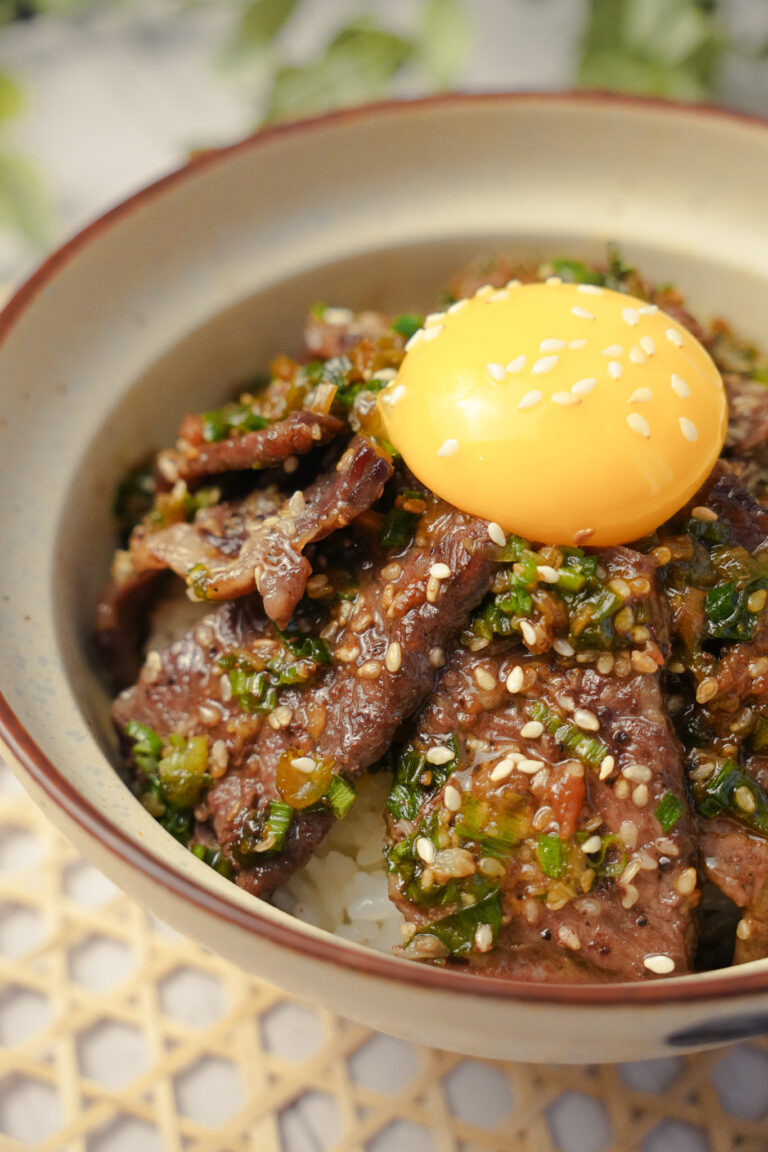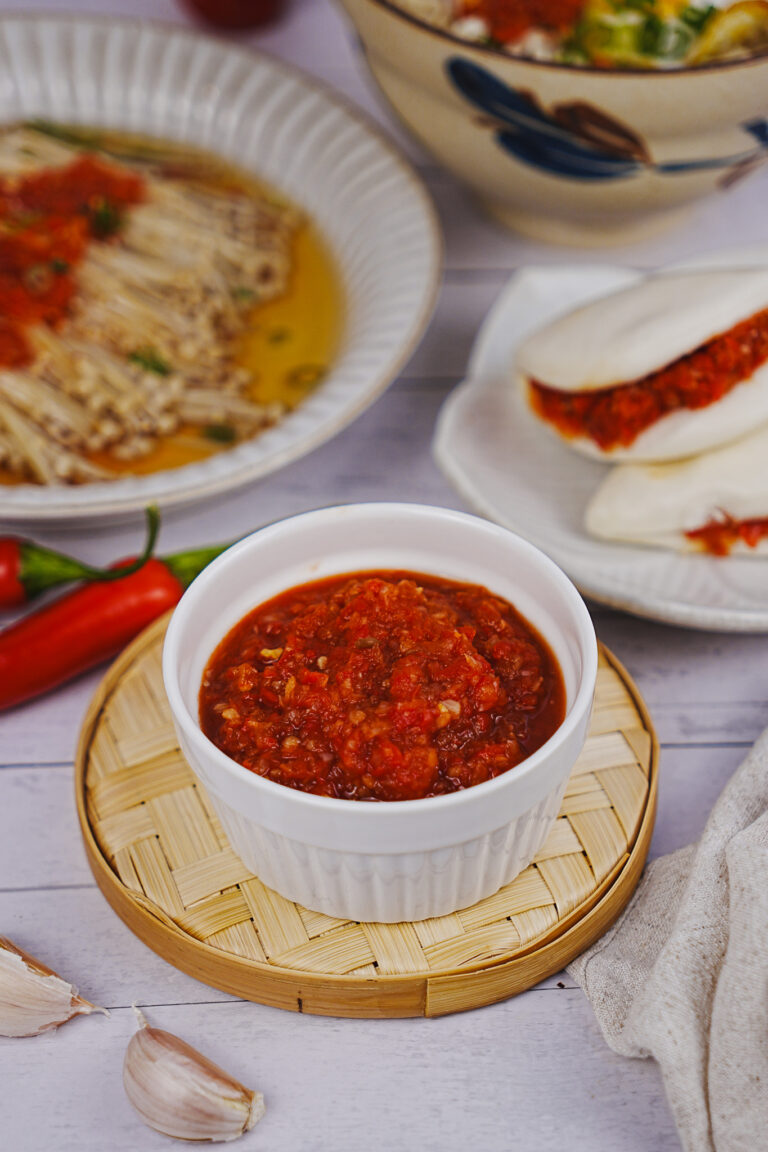Chinese Braised Beef Shank Noodle Soup – Rich, Flavorful, and Perfect for Meal Prep
If you’re craving something comforting, rich in flavor, and easy to prep ahead, this Chinese Braised Beef Shank Noodle Soup (酱牛肉) is exactly what you need. The beef is slow-braised with spices and fermented sauces until deeply savory, tender yet structured, and packed with umami. Whether you serve it hot in a noodle soup, cold as a sliced appetizer, or toss it into a quick salad, this dish is incredibly versatile and satisfying.
I always keep a batch of braised beef shank in the fridge or freezer. It’s my secret weapon for busy days. Even if I come home late, I can throw together a comforting bowl of beef noodle soup in just minutes — and my family absolutely loves it.
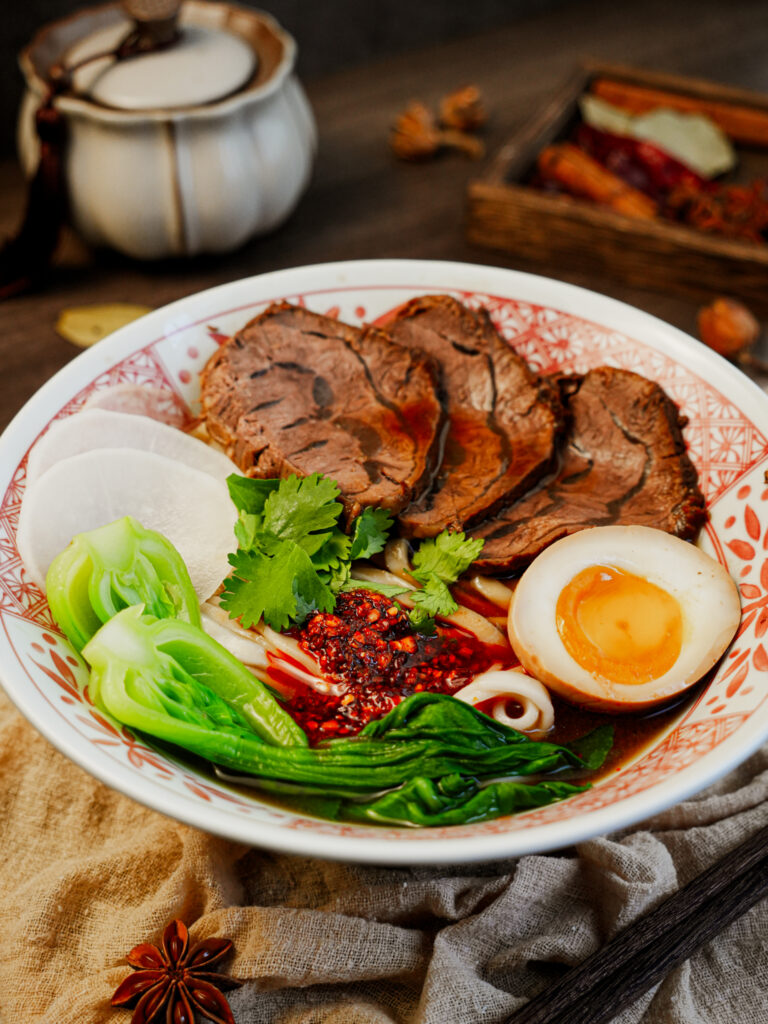
What Makes a Great Braised Beef Shank?
A good piece of braised beef shank should have a glossy, light brown color. The muscle should be firm and intact when sliced, while the tendons inside turn slightly translucent and golden. When you bite into it, the beef should be salty-sweet, infused with rich soy aroma, and incredibly tender — never dry or mushy.

Why Beef Shank?
Beef shank is the ideal cut for this recipe. It has a beautiful balance of lean meat and tendon, which creates that satisfying bite after a slow braise. The tendon melts slightly while the meat remains dense and flavorful. When cooked just right, it slices beautifully into thin, clean pieces and holds its shape perfectly — ideal for both noodle soups and cold dishes.
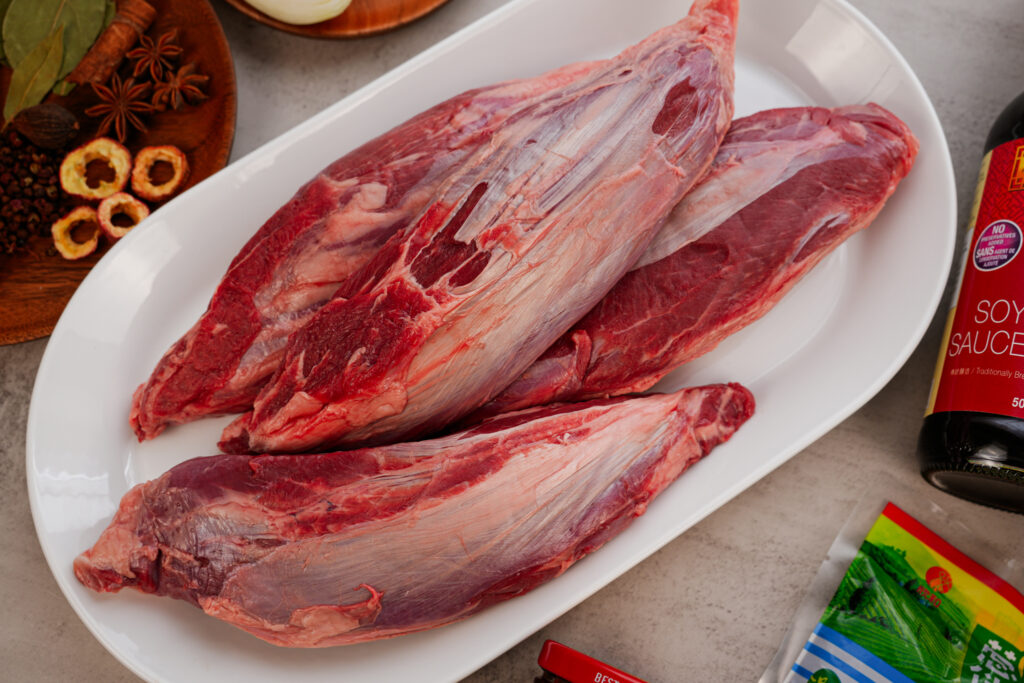
The Power of Fermented Soy
This recipe uses a combination of soy sauce, Chinese sweet soybean paste, and fermented red bean curd. All three are traditional fermented products made from soybeans, and each brings something unique to the table.
- Soy sauce adds salinity and depth.
- Sweet soybean paste contributes a malty sweetness and thick texture.
- Fermented red bean curd brings umami and a subtle funk that enhances the overall complexity.
Together, they create a layered flavor profile that you simply can’t get from plain seasoning. This trio is the soul of a good braised beef shank.
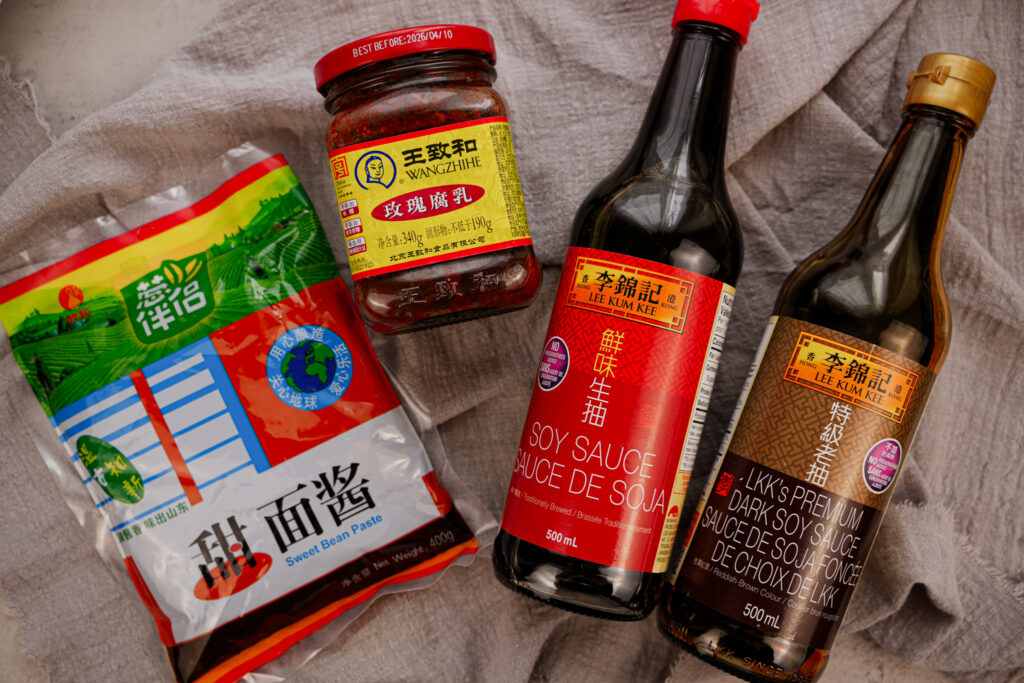
How to make Chinese Braised Beef Shank Noodle Soup
Ingredients
- 4 lb beef shank
- 1 cup plus 2 tbsp soy sauce (300g)
- 1 tbsp dark soy sauce
- ½ cup Chinese sweet soybean paste (160g)
- 3 pieces fermented red bean curd (about 25g)
- 40g ginger, sliced thick
- ½ medium white onion
- 5 cups water
- Salt to taste (optional)
Spices:
- 1 tbsp Sichuan peppercorn
- 3 star anise
- 1 small cinnamon stick (3g)
- 5–6 bay leaves
- 1 black cardamom
- 6 dried bird’s eye chilies (optional, it only adds gentle heat, barely noticeable)
- 4–5 pieces dried hawthorn fruit (optional, adds subtle tartness)
- 1 piece dried tangerine peel (陈皮, optional, about 2g)
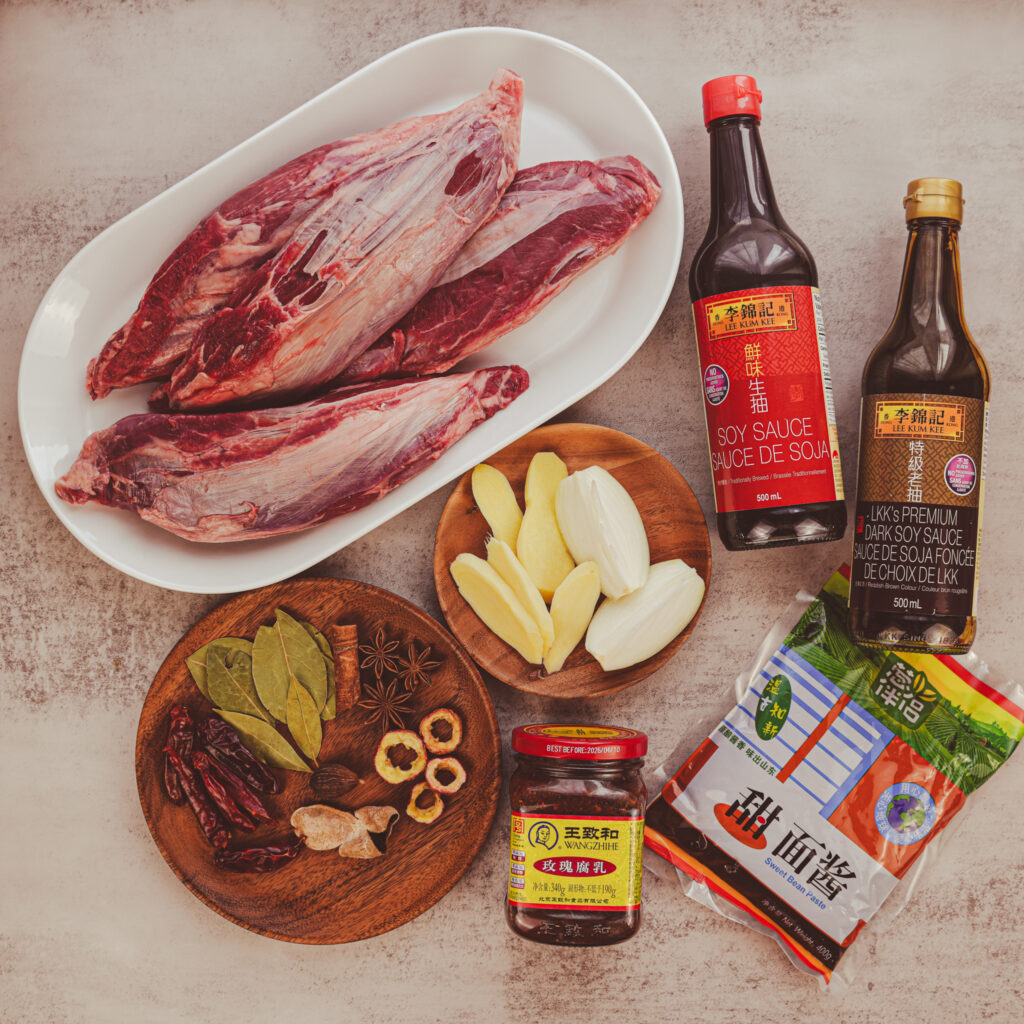
Step-by-Step Instructions
1. Soak the Beef
Start by soaking the beef shank in cold water for at least 2 hours. This helps draw out any blood and unwanted flavors, giving you a cleaner, better-tasting broth.
2. Blanch
Place the beef shank in a Dutch oven or large pot and add about 5 cups of water, enough to submerge the meat. Bring it to a boil, then skim off any foam or impurities that rise to the surface. This step helps keep the broth clear and clean.
3. Build the Base
In a small dry pan, lightly toast all the spices until fragrant. Add them to the pot with the beef. Then add the ginger and onion. Stir in soy sauce, dark soy sauce, sweet soybean paste, and fermented red bean curd. Give the liquid a quick taste and adjust with salt if needed.
4. Simmer
Once the liquid comes back to a boil, reduce the heat to low, cover, and let it simmer gently for 1.5 to 2 hours. The beef is done when a chopstick can poke through the thickest part with a bit of resistance. Don’t overcook! The goal is tender, not falling apart, so it slices cleanly later.
5. Let It Soak Overnight
When the beef is fully cooked, turn off the heat and let it cool in the braising liquid. You can enjoy it right away, but for the best flavor, cover and refrigerate it overnight. This allows the meat to soak up all the delicious aromatics. You can also drop a few boiled eggs into the braising liquid to make flavorful marinated eggs for the noodles. (*Note 1)
6. Assemble the Noodles
Boil your favorite wheat noodles (I like thicker ones for this dish). In the last minute of cooking, toss in bok choy and thinly sliced daikon radish. Drain and place everything into a serving bowl. Thinly slice the chilled beef shank against the grain and lay it over the noodles (*Note 2). Add one marinated egg. Ladle in 1–2 ladles of the warmed up braising broth, and 1-2 ladles of the noodle cooking water to balance the flavor. Top with chopped cilantro, green onion, and a spoonful of chili oil if you like a bit of heat.
Notes:
NOTE 1: Storage
I recommend soaking the beef in the braising liquid in the fridge for less than 3 days. It might become too salty if soaking for too long. After that, drain and store it in an airtight container for up to 1–2 weeks, or wrap individual slices in cling film and freeze for up to 3 months.
NOTE 2: Cutting Tip
Always slice the beef thinly against the grain for the most tender bite. It’s easier to do this when the beef is cold, straight from the fridge.
Other Noodle Recipes You Might Like:
- Chinese Braised Beef Noodle Soup (红烧牛肉面)
- 15-Minute Spicy Garlic Noodles (鸡丝凉面)
- Beef Chow Fun (干炒牛河)
Looking for more authentic recipes? Be sure to follow me on Pinterest, Instagram, Tiktok and Youtube!
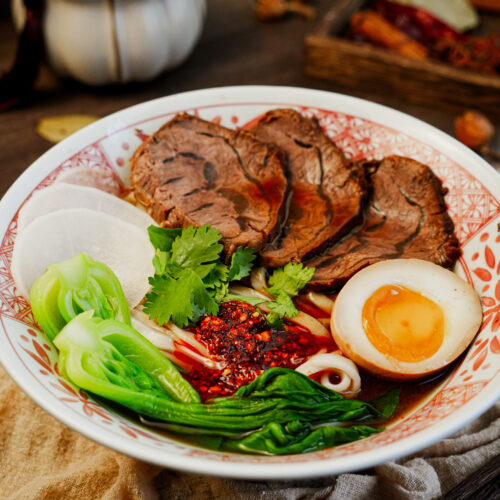
Chinese Braised Beef Shank Noodle Soup
Equipment
- 1 dutch oven or large pot
Ingredients
- 4 lb beef shank
- 1 cup +2 tbsp soy sauce 300g
- 1 tbsp dark soy sauce
- ½ cup Chinese sweet soybean paste 160g
- 3 pieces fermented red bean curd about 25g
- 40 g ginger sliced thick
- ½ white onion medium size
- 5 cups water
- Salt to taste optional
Spices:
- 1 tbsp Sichuan peppercorn
- 3 star anise
- 1 small cinnamon stick 3g
- 5-6 bay leaves
- 1 black cardamom
- 6 dried bird’s eye chilies optional, it only adds gentle heat, barely noticeable
- 4-5 pieces dried hawthorn fruit optional, adds subtle tartness
- 1 piece dried tangerine peel 陈皮, optional, about 2g
Instructions
Soak the Beef
- Start by soaking the beef shank in cold water for at least 2 hours. This helps draw out any blood and unwanted flavors, giving you a cleaner, better-tasting broth.
Blanch
- Place the beef shank in a Dutch oven or large pot and add about 5 cups of water, enough to submerge the meat. Bring it to a boil, then skim off any foam or impurities that rise to the surface. This step helps keep the broth clear and clean.
Build the Base
- In a small dry pan, lightly toast all the spices until fragrant. Add them to the pot with the beef. Then add the ginger and onion. Stir in soy sauce, dark soy sauce, sweet soybean paste, and fermented red bean curd. Give the liquid a quick taste and adjust with salt if needed.
Simmer
- Once the liquid comes back to a boil, reduce the heat to low, cover, and let it simmer gently for 1.5 to 2 hours. The beef is done when a chopstick can poke through the thickest part with a bit of resistance. Don’t overcook! The goal is tender, not falling apart, so it slices cleanly later.
Let It Soak Overnight
- When the beef is fully cooked, turn off the heat and let it cool in the braising liquid. You can enjoy it right away, but for the best flavor, cover and refrigerate it overnight. This allows the meat to soak up all the delicious aromatics. You can also drop a few boiled eggs into the braising liquid to make flavorful marinated eggs for the noodles. (*Note 1)
Assemble the Noodles
- Boil your favorite wheat noodles (I like thicker ones for this dish). In the last minute of cooking, toss in bok choy and thinly sliced daikon radish. Drain and place everything into a serving bowl. Thinly slice the chilled beef shank against the grain and lay it over the noodles (*Note 2). Add one marinated egg. Ladle in 1–2 ladles of the warmed up braising broth, and 1-2 ladles of the noodle cooking water to balance the flavor. Top with chopped cilantro, green onion, and a spoonful of chili oil if you like a bit of heat.
Notes
I recommend soaking the beef in the braising liquid in the fridge for less than 3 days. It might become too salty if soaking for too long. After that, drain and store it in an airtight container for up to 1–2 weeks, or wrap individual slices in cling film and freeze for up to 3 months. NOTE 2: Cutting Tip
Always slice the beef thinly against the grain for the most tender bite. It’s easier to do this when the beef is cold, straight from the fridge.




